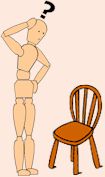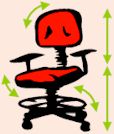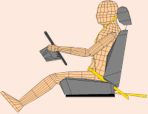 |
What
makes a seat comfortable?
Generally, seats should allow your body
to be comfortable and not restricted. The seat design is critical for this:
-
The seat height should not be so
high so that your legs are left dangling! This would mean that there
would be pressure on the soft tissues under your thighs. This pressure interferes with the return of blood from the lower limbs, which may cause tingling and numbness in the thighs due to pressure on blood vessels and nerves.
-
The seat depth should allow clearance
at the back of your knees in order to prevent pressure on the network of blood vessels and
nerves.
-
The seat back and angle should support the natural curves
of your spine (in particular your lower back).
-
The main weight bearing should be taken by the ischial tuberosities
(the bony parts of your bottom) and the top half of the thighs.
In addition, a chair should enable you to change posture at intervals, ensuring that different groups of muscles
can be used for support, and that no particular group of muscles gets
tired. The consequences of poor seating are discomfort, fatigue and inefficiency
in what you are doing.
|
Legal requirements for seating facilities at work
The British Standard for Office Furniture (BS 5940) covers chairs, footrests, fixed and adjustable workstations.
|
|
|
|
| |
GUIDELINES FOR DESIGN |
|
|
OFFICE
CHAIRS
 Aches and pains can be suffered by office workers as a result of
poor seating and workspace layout. But there is plenty that can be done
to make them more comfortable. Aches and pains can be suffered by office workers as a result of
poor seating and workspace layout. But there is plenty that can be done
to make them more comfortable.
Recommendations:
-
The seat height should
be adjustable. BS 5940 recommends a minimum acceptable range of 420-500mm. Pheasant (2001) suggests that a range of 380-535mm.
-
The seat edge should
be rounded to minimise pressure under the thigh.
-
The seat pan should tilt forwards and backwards (about 5°).
-
The seat base should swivel
and have 5 or more castors (for stability).
-
The backrest should be
adjustable and about 500mm in height. It should also be contoured to support the lumbar curve of the
back.
-
The backrest should tilt
for support in both a working and resting posture.
-
If the seat and backrest do not adjust independently, the angle between them should be about 105°.
-
The upholstery material should not cause sliding or
sweating.
-
Footrests should be provided to allow shorter people to adjust themselves to the desk or
worktop (BS 5940 recommends a minimum 450mm length x 350mm width).
-
Armrests may prevent the user from getting close to the desk but they can assist resting the elbows during work.
If they are fixed they should not extend more than about 200-250mm in front of the seat back.
Many office workers do not adjust their chair at
work even though they know how to do so. To encourage them to do so and take advantage of all the adjustment mechanisms in their chairs, controls should be easy and intuitive to operate from the seated position.
|
| ARMCHAIRS
 An armchair supports the body during rest or relaxation,
for example, when reading or watching television. The design of the armchair presents a
dilemma. People usually sprawl in armchairs rather than sit up straight
in them. Armchairs should allow the relaxation of muscles as well as support
of the spine in its natural curve. Many armchairs fail to achieve this as they are often too deep and too soft with inadequate backrests (too low and poor
shapes). This makes it very difficult to achieve 'good postures'. If the
seat is too low, standing up and sitting down are difficult for some
users. The seat height for comfort is not necessarily the same as the height required for ease of getting
in and out of the chair. Appropriate
armchair design is particularly important for older and disabled users. An armchair supports the body during rest or relaxation,
for example, when reading or watching television. The design of the armchair presents a
dilemma. People usually sprawl in armchairs rather than sit up straight
in them. Armchairs should allow the relaxation of muscles as well as support
of the spine in its natural curve. Many armchairs fail to achieve this as they are often too deep and too soft with inadequate backrests (too low and poor
shapes). This makes it very difficult to achieve 'good postures'. If the
seat is too low, standing up and sitting down are difficult for some
users. The seat height for comfort is not necessarily the same as the height required for ease of getting
in and out of the chair. Appropriate
armchair design is particularly important for older and disabled users.
Recommendations:
- The seat backrest angle should be 105-110°. A rake of more than 110° may cause problems for older users getting in and out.
- Armrests should be slightly sloped so that they are lower at the back for comfort and higher at the front to
enable easy rising from the chair.
Other considerations in armchair design are fire
retardancy,
type of upholstery, suspension, wear and tear, leg design (not yours!), headrests and the situation in which it is to be used.
|
|
CAR
SEATS
Back pain is common
amongst drivers and there are several reasons for this: driving forces prolonged sitting in a fixed posture;
transference of vibration; and loss of spine support due to a poorly fitting seat.
 Recommendations (in
addition to those for general seating): Recommendations (in
addition to those for general seating):
-
Good visibility of the road
should be possible, together with a good view of all the
instruments.
-
The driver should be
able to reach all of the controls (pedals and hand controls) without
stretching.
-
The body should be
supported and muscular effort minimised to allowing the driver to concentrate on the driving
task.
-
Shaping and padding
should allow good distribution of body weight over the seat.
-
Vibration and shock
transfer should be minimised.
In order to minimise discomfort, the
driver's seat should also offer as many adjustable features as possible. The most important
ones are:
-
Backwards and forwards
adjustment of the seat,
-
Backrest angle
adjustment,
-
Seat height adjustment – ideally independently adjustable at the front and rear of the
seat,
-
Seat angle adjustment,
-
Adjustable lumbar
(lower back) support - up/down and in/out,
-
Headrest adjustment -
vertical, horizontal and tilt.
The more adjustable features within the car (e.g. steering wheel adjustment in/out, up/down and tilt), the greater the likelihood of the driver achieving good and comfortable postures.
But any posture, no matter how good it is, can lead to discomfort if it is held for too long. Therefore, it is important to adopt a range of comfortable driving positions and to make frequent
stops to avoid, or help delay, the onset of discomfort. Ease of use of any adjustable feature is therefore crucial.
|
|
MULTI-PURPOSE
SEATS
 Multi-purpose seats are intended for a variety of uses: in dining rooms, bedrooms, work areas, and as spare chairs. They are also used in public spaces such as waiting rooms, conference centres and libraries, where they often have to be stacked for storage. General requirements for seats can be applied to multipurpose chairs. However, such chairs will not usually be maximally comfortable in all situations and compromises will often have to be made.
It is difficult to design a seat that is comfortable both for a forward-inclined posture (a dining table) and a backward leaning posture (listening to a talk). Taller and shorter users may be particularly uncomfortable with certain chairs. Multi-purpose seats are intended for a variety of uses: in dining rooms, bedrooms, work areas, and as spare chairs. They are also used in public spaces such as waiting rooms, conference centres and libraries, where they often have to be stacked for storage. General requirements for seats can be applied to multipurpose chairs. However, such chairs will not usually be maximally comfortable in all situations and compromises will often have to be made.
It is difficult to design a seat that is comfortable both for a forward-inclined posture (a dining table) and a backward leaning posture (listening to a talk). Taller and shorter users may be particularly uncomfortable with certain chairs.
Recommendations:
-
The seat and backrest should be
upholstered with a gently-rounded lumbar support.
-
The seat surface should be gently moulded
with slight concavity under the buttocks.
-
The depth of the seat should not exceed 430mm in order that the backrest is effective for smaller users.
-
The height of a flat seat surface
should be 400–460mm.
-
The material for the seat cover should allow for air circulation and not be slippery.
As compromises between postures, comfort and the purpose of the chair are unavoidable, a choice of models (e.g. different heights, profiles, upholstering
etc.) is better for the consumer.
|
|
